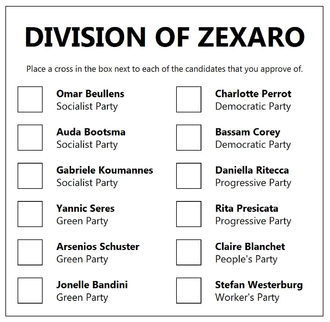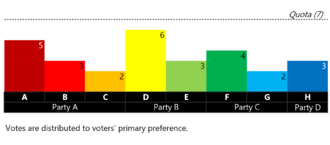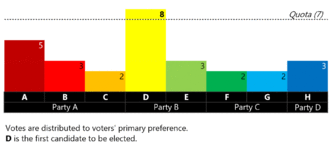Difference between revisions of "Llorenian federal election, 2016"
m (→Vusmein) |
m |
||
| Line 5: | Line 5: | ||
| header2 = Socialist Party | | header2 = Socialist Party | ||
| label3 = Leader | data3 = Elisabeth Harland | | label3 = Leader | data3 = Elisabeth Harland | ||
| − | |||
| label5 = Seats won | data5 = 26 | | label5 = Seats won | data5 = 26 | ||
| header6 = Green Party | | header6 = Green Party | ||
| label7 = Leader | data7 = Josef Cervenka | | label7 = Leader | data7 = Josef Cervenka | ||
| − | |||
| label9 = Seats won | data9 = 22 | | label9 = Seats won | data9 = 22 | ||
| header10 = Progressive Party | | header10 = Progressive Party | ||
| label11 = Leader | data11 = Ludoviko Zabat | | label11 = Leader | data11 = Ludoviko Zabat | ||
| − | |||
| label13 = Seats won | data13 = 19 | | label13 = Seats won | data13 = 19 | ||
| header14 = Democratic Party | | header14 = Democratic Party | ||
| label15 = Leader | data15 = Amara Adriaansen | | label15 = Leader | data15 = Amara Adriaansen | ||
| − | |||
| label17 = Seats won | data17 = 15 | | label17 = Seats won | data17 = 15 | ||
| header18 = Worker's Party | | header18 = Worker's Party | ||
| label19 = Leader | data19 = Stefan Westerburg | | label19 = Leader | data19 = Stefan Westerburg | ||
| − | |||
| label21 = Seats won | data21 = 7 | | label21 = Seats won | data21 = 7 | ||
| header22 = People's Party | | header22 = People's Party | ||
| label23 = Leader | data23 = Alberta Bertolini | | label23 = Leader | data23 = Alberta Bertolini | ||
| − | |||
| label25 = Seats won | data25 = 4 | | label25 = Seats won | data25 = 4 | ||
| header26 = National Party | | header26 = National Party | ||
| label27 = Leader | data27 = Dorriane Kuiper | | label27 = Leader | data27 = Dorriane Kuiper | ||
| − | |||
| label29 = Seats won | data29 = 2 | | label29 = Seats won | data29 = 2 | ||
| header30 = Independents | | header30 = Independents | ||
| Line 35: | Line 28: | ||
}} | }} | ||
| − | The '''Llorenian federal election, 2016''' was the first election in [[Llorens]]' history, and was held on June 24, 2016 to elect the 1st Parliament. The party that resulted in the most seats was the Socialist Party, with 26 seats. As a result of this, Elisabeth Harland, the party's leader, was appointed President. The second-most successful party was the Green Party, with 22 seats. Josef Cervenka, their party leader, was consequently appointed Vice-President. This election used a single transferable voting system to elect 100 members of Parliament. | + | The '''Llorenian federal election, 2016''' was the first election in [[Llorens]]' history, and was held on June 24, 2016 to elect the 1st Parliament. The party that resulted in the most seats was the Socialist Party, with 26 seats. As a result of this, Elisabeth Harland, the party's leader, was appointed President. The second-most successful party was the Green Party, with 22 seats. Josef Cervenka, their party leader, was consequently appointed Vice-President. |
| + | |||
| + | This election used a single transferable voting system to elect 100 members to [[Parliament of Llorens|Parliament]]. | ||
==Results== | ==Results== | ||
Revision as of 19:39, 30 July 2016
The Llorenian federal election, 2016 was the first election in Llorens' history, and was held on June 24, 2016 to elect the 1st Parliament. The party that resulted in the most seats was the Socialist Party, with 26 seats. As a result of this, Elisabeth Harland, the party's leader, was appointed President. The second-most successful party was the Green Party, with 22 seats. Josef Cervenka, their party leader, was consequently appointed Vice-President.
This election used a single transferable voting system to elect 100 members to Parliament.
Contents
Results
Overall
Popular Vote
Number of Seats
States
Vusmein
| Division | Name | |
|---|---|---|
| Zexaro | Stefan Westerburg | |
| Omar Beullens | ||
| Yannic Seres | ||
| Claire Blanchet | ||
| Arsenios Schuster | ||
| Vusmein City | Josef Cervenka | |
| Bartolomeu Berkowitz | ||
| Vincente Accursio | ||
| Alonso Richetti | ||
| Angeline Hernandez | ||
| Niemvusen | Dianne Romanov | |
| Juliana Gallo | ||
| Kaoru Sung | ||
| Almira Albertina | ||
| Taichiya Bucharov | ||
| Regional Vusmein | Veselko Steuben | |
| Robben Berne | ||
| Adrian Bergmann | ||
| Cirino Pann | ||
| Elisaveta Bastori | ||
Ytelia
| Division | Name | |
|---|---|---|
| Liteya | Amara Adriaansen | |
| Kenneth Alden | ||
| Aridai Devine | ||
| Evariste Alves | ||
| Theo Karl | ||
| Point Ytelia | Auda Bootsma | |
| Jasmine Cassidy | ||
| Alberto Cohen | ||
| Gabriel Koumannes | ||
| Juan Zoldos | ||
| Port Llorenç | Ludoviko Zabat | |
| Petronella Lindholm | ||
| Gianna Mortina | ||
| Peta van der Rort | ||
| Lilliana Porter | ||
| Regional Ytelia | Tahnee Mihaylov | |
| Viviane Stark | ||
| Joseph Oliver | ||
| Khadija Nardorvino | ||
| Jacinto Kranze | ||
Xeñana
| Division | Name | |
|---|---|---|
| Xeñana City | Fraser Zilberschlag | |
| Dominique Bernard | ||
| Fernando Borgogni | ||
| Vera Bogdanovic | ||
| Merita Harmann | ||
| Zañtanas | Aria Bogmolov | |
| Marganita Ackermann | ||
| Olivia Fontana | ||
| Karolina Abel | ||
| Pedro Vivez | ||
| Ceybisa | Anzhela Gouveia | |
| Bevan Messerli | ||
| Valerie Nguyen | ||
| Elizabeth Gunther | ||
| Denise Frank | ||
| Regional Xeñana | Bruno Weiss | |
| Gordon Francis | ||
| Kevin Ottosan | ||
| Giuliana Rinaldi | ||
| Farooq Herreira | ||
Rinturè
| Division | Name | |
|---|---|---|
| Xerturini | Clair Kaufmann | |
| Nathan Bloxham | ||
| Laurentius Arena | ||
| Roshan Duschamps | ||
| Thomas Erdos | ||
| Porterano | Serafino Gerillo | |
| Symeon Pospisil | ||
| Joanna Vasilev | ||
| Ragnvald Schneijder | ||
| Lilliana Bartitos | ||
| Notonfigo | Elisabeth Harland | |
| Alberta Bertolini | ||
| Charlotte Perrot | ||
| Jonelle Bandini | ||
| Bernadine Hashimoto | ||
| Regional Rinturè | Dorriane Kuiper | |
| Timaeus Wendel | ||
| Katherine Steffensen | ||
| Lara Nicastro | ||
| Lydia Timberlake | ||
Zana
| Division | Name | |
|---|---|---|
| Zanaville | Prasert Rhodes | |
| Jehanne Sommer | ||
| Alexandrea Jackson | ||
| Satomi Klausen | ||
| Alla Ybarra | ||
| Valstana | Silvio Stoyanov | |
| Malina Jankovic | ||
| Atte Adarlardi | ||
| Victor Levitt | ||
| Michael O'Shea | ||
| Mount Sanotoza | Dustin Herberts | |
| Jasmina Emile | ||
| Mei Kasun | ||
| Ilona Concordia | ||
| Cosette Cingolani | ||
| Regional Zana | Aurora Paredes | |
| Rodrigo Sadowski | ||
| Zorana Pedrotti | ||
| Adair Airaldi | ||
| Karmela Akkero | ||
Methodology
Voting
Eligible voters cast their ballot on a single piece of paper displaying each of the parties and candidates for their district. Using a single transferable voting system, they can rank all the parties (left side) or can rank at least 8 candidates (right side).
The leader of the party with the most seats in Parliament is elected President, and the leader of the party with the second-most seats in Parliament is elected Vice-President. If either the party with the most seats or second-most seats is tied, a President/Vice-President will be elected by a majority vote in Parliament (excluding members of the tied parties). If this vote is still tied, a national direct vote will select the relevant position.
Counting
Firstly, votes are distributed to the candidate whom voters placed a 1 next to. If no candidate has reached the indicated quota, the number of votes that are needed for a candidate to be elected, then the candidate/s with the lowest number of votes is eliminated, and those who voted for the eliminated candidate/s will have their vote distributed to their second preference.
If there is a candidate with an excess of votes, all the second preferences of their voters will be distributed in a ratio, so that the original candidate has the number of votes needed to fulfil the quota. This process continues until all five member positions in a district have been filled from obtaining the quota.




